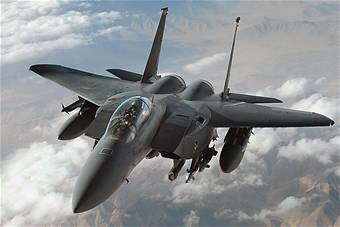
NEWSROOM
 |
NEWSROOM |
|
|
|
|
|||
|
F-15E Accident Investigation Report Released
By Air Force By Mike Mitchell |
||||
 |
December 1, 2009 - Two Air Force officers were
killed July 18 in the crash of an F-15E Strike Eagle. The aircraft,
assigned to Seymour Johnson Air Force Base, N.C., was flying in support
of coalition operations in eastern A team of
The crew was killed upon impact, and the $55 million aircraft, assigned
to the 4th Fighter Wing, was destroyed.
|
|||
|
An F-15E, similar to this one, crashed in |
||||
|
The
flight lead flew the first practice strafing attack, but discontinued
the approach because his angle of attack was too shallow. The mishap
crew began their attack and impacted the ground 10 seconds later. No
attempt to pull out of the attack was made, and neither the pilot nor
the weapons systems officer attempted to eject. The F-15E Strike Eagle is a American all-weather ground attack strike fighter. It was designed in the 1980s for long-range, high speed interdiction without relying on escort or electronic warfare aircraft. The Strike Eagle, a major derivative of the F-15 Eagle air superiority fighter proved its worth in Operation Desert Storm and Operation Allied Force, carrying out deep strikes against high-value targets, combat air patrols, and providing close air support for coalition troops. It has also seen action in later conflicts and has been exported to several countries. United States Air Force F-15E Strike Eagles can be distinguished from other U.S. Eagle variants by darker camouflage and conformal fuel tanks mounted along the engine intakes. |
||||
|
In 1979, McDonnell Douglas and F-15 radar
manufacturer, Hughes teamed to privately develop a strike version of the
F-15. In March 1981, the USAF announced the Enhanced Tactical Fighter
program to procure a replacement for the F-111 Aardvark. The concept
envisioned an aircraft capable of launching deep interdiction missions
without requiring additional support by fighter escort or jamming.
General Dynamics submitted the F-16XL, while McDonnell Douglas submitted
a variant of the F-15 Eagle with two seats. On 24 February 1984, the
USAF awarded the ETF to McDonnell Douglas' F-15E Strike Eagle. One of
the prime reasons the Air Force selected the F-15E over the F-16XL was
the F-15E's 40% lower development costs. Also, the F-15E had more room
for growth and has better survivability with two engines. The Air Force
initially planned to purchase 392 F-15Es.
The F-15E's first flight was on 11 December 1986. The
first production model of the F-15E was delivered to the 405th Tactical
Training Wing, Luke Air Force Base, Variants of the F-15E have been developed for While most of the F-15C/Ds are being replaced by the F-22 Raptor there is no slated replacement for the F-15E. The Strike Eagle is a more recent variant of the F-15, and has a sturdier airframe rated for twice the lifetime of earlier variants. The F-15Es are expected to remain in service past 2025. The Air Force is currently pursuing the 2018 Bomber, a medium bomber concept which could also take over the Strike Eagle's "deep strike" profile. The "A" variant of the F-35 Lightning II, which is projected to eventually replace many other attack aircraft such as the F-16 Fighting Falcon and A-10 Thunderbolt II, could also take over much of the F-15E's role. |
| ?AvStop Online Magazine Contact Us Return To News |